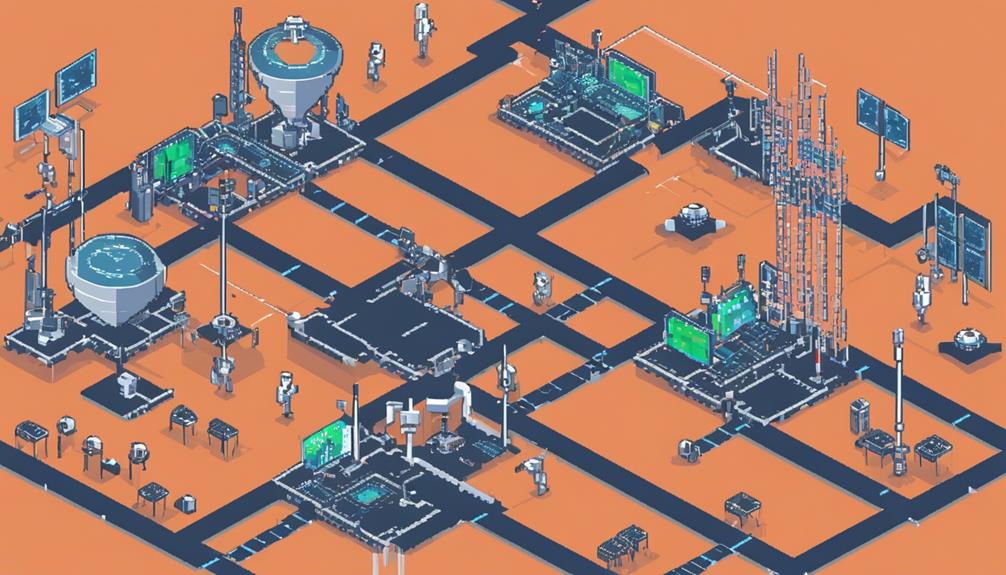Ground stations serve as the backbone of satellite networks, functioning as the critical link between satellites orbiting in space and the terrestrial infrastructure on Earth. These stations facilitate the exchange of data, commands, and telemetry between ground-based operators and satellites, enabling a wide range of applications from telecommunications to weather monitoring. The intricate processes involved in signal acquisition, tracking, and control operations highlight the indispensable role of ground stations in ensuring the seamless functioning of satellite networks. As technology advances and demands for satellite services grow, the evolution and adaptation of ground station capabilities remain paramount to the success and reliability of satellite operations.
Key Takeaways
- Ground stations are vital for satellite communication, enabling data exchange and accurate tracking.
- They play a crucial role in signal transmission and reception, enhancing connectivity with satellites.
- Advanced technology in ground stations ensures effective satellite tracking and command operations.
- Efficient data transmission management in ground stations is essential for optimal satellite functionality.
Significance of Ground Stations

Ground stations serve as critical communication hubs in satellite networks, facilitating the exchange of signals between satellites and Earth stations with precision and efficiency. These stations are vital for the seamless flow of data between space and Earth. Ground stations have the essential role of receiving data from satellites orbiting the Earth and transmitting data back to these satellites. They are equipped with sophisticated technology to track satellite movement accurately, ensuring constant communication links with orbiting satellites.
Moreover, ground stations play a pivotal role in processing and converting data for terrestrial networks, thereby enhancing the quality of the transmitted information. This data processing capability is crucial for various applications, including weather forecasting, GPS navigation, and research. Additionally, ground stations are instrumental in supporting emergency communications during critical situations, providing a reliable means of transmitting vital information when traditional communication channels may be compromised.
Furthermore, these stations implement robust security measures such as encryption and firewalls to protect data transmission effectively. By safeguarding the integrity and confidentiality of transmitted data, ground stations ensure the secure exchange of information between satellites and Earth stations. Overall, the significance of ground stations in satellite networks cannot be overstated, as they form the backbone of communication infrastructure in the realm of space technology.
Signal Transmission and Reception
In the realm of satellite networks, the efficient transmission and reception of signals between ground stations and satellites are paramount for ensuring seamless communication infrastructure. Ground stations rely on antennas to facilitate the transmission and reception of signals to and from satellites. These antennas play a crucial role in establishing and maintaining connections with satellites, enabling the ground stations to facilitate reliable signal transmission and ensure effective communication within the network.
Signal transmission from ground stations to satellites is a fundamental aspect of satellite communication systems. The accuracy and efficiency of this transmission are essential for the seamless operation of the satellite network. Ground stations are equipped with specialized antennas that are designed to transmit signals to satellites with precision and reliability.
Conversely, signal reception from satellites is equally important for ground stations. The ability to receive data and information from satellites allows ground stations to exchange crucial data and maintain communication links within the network. Ground stations are strategically positioned to optimize signal reception from satellites, ensuring the timely and accurate exchange of information.
Satellite Tracking Capabilities
Utilizing advanced software and sophisticated orbital propagators, satellite tracking capabilities enable ground stations to precisely monitor and predict the positions of satellites in orbit. Ground stations rely on antenna tracking systems to determine azimuth and elevation commands, ensuring precise orientation towards satellites for effective communication. Updated Two Line Elements (TLE) containing orbital parameters are essential for antenna tracking and predicting satellite visibility, enabling ground stations to adjust their tracking systems accordingly.
To maintain communication with satellites, ground stations process multiple signals across different frequencies, allowing for robust RF communication. Closed-loop control systems integrated into antenna tracking mechanisms provide feedback control, contributing to accurate satellite tracking and reliable communication links. These systems continuously update and adjust the antenna's position to compensate for any deviations in the satellite's orbital path, ensuring uninterrupted tracking and communication capabilities.
Command and Control Operations
Command and control operations at ground stations are pivotal for remote satellite monitoring and data transmission management. These operations involve sending precise commands to satellites to execute various functions, ensuring optimal performance and mission success. Ground stations play a critical role in overseeing satellite health, managing payload activities, and conducting necessary orbital maneuvers to maintain operational efficiency.
Remote Satellite Monitoring
Conducting remote satellite monitoring through ground stations involves the precise tracking of spacecraft orbits, positions, and velocities to facilitate efficient command and control operations. Ground stations are essential for sending commands to satellites, enabling operations such as payload control and orbit adjustments. Real-time data processing at these stations plays a crucial role in making informed decisions for satellite mission management. Additionally, ground stations are vital for ensuring the security and integrity of satellite communication networks. By remotely conducting command and control operations from ground stations, the efficiency and effectiveness of satellite operations are significantly enhanced.
| Ground Stations | Satellite Communication |
|---|---|
| Data Processing | Command and Control Operations |
Data Transmission Management
Ground stations in satellite networks meticulously manage data transmission for command and control operations, ensuring precise communication and efficient satellite functionality. Serving as a communication hub, these stations play a vital role in receiving signals from satellites to facilitate various command operations. By sending commands for orbital adjustments, payload control, and overall satellite management, ground stations enable effective monitoring and control of satellite operations. The accurate reception and transmission of data are essential for maintaining the functionality and performance of satellite networks. Through their meticulous data transmission management, ground stations contribute significantly to the smooth operation and coordination of satellite systems, ensuring seamless communication and optimal satellite functionality.
Data Processing and Conversion

Data processing and conversion in ground stations play a crucial role in transforming raw signals received from satellites into actionable data for various applications. Ground stations are equipped with specialized hardware and software designed to process and analyze data efficiently. The conversion of data formats and protocols is a fundamental aspect of data processing in ground stations, ensuring seamless integration with terrestrial networks. This conversion enables the data to be transmitted and utilized across different systems, enhancing the interoperability of satellite networks with existing infrastructure.
Ground stations are responsible for ensuring the accuracy and reliability of the processed data to support a wide range of applications, including weather forecasting and navigation. By executing efficient data processing and conversion procedures, ground stations contribute significantly to the overall performance of satellite networks. The processed data is essential for decision-making processes in sectors such as agriculture, telecommunications, and disaster management.
Emergency Communication Support
During critical situations such as natural disasters and humanitarian crises, ground stations serve as indispensable hubs for providing essential emergency communication support. These stations play a crucial role in enabling rapid deployment of communication services to affected areas, aiding in rescue and relief efforts. Here are key points highlighting the significance of emergency communication support provided by ground stations:
- Rapid Deployment: Ground stations facilitate the swift establishment of communication links in disaster-stricken regions, ensuring timely assistance to those in need.
- Coordination: They help in coordinating efforts among response teams, government agencies, and humanitarian organizations, enhancing the overall effectiveness of rescue and relief operations.
- Reliability: Satellite communication via ground stations offers a reliable alternative when terrestrial networks are disrupted during emergencies, ensuring continuous connectivity for critical communications.
- Life-saving Role: Emergency communication services supported by ground stations are instrumental in saving lives and managing crisis situations effectively, making them a vital component of disaster response mechanisms.
Ensuring Network Reliability and Security

Amid the critical infrastructure requirements of satellite networks, ensuring network reliability and security stands as a paramount concern in the realm of telecommunications technology. Ground stations play a vital role in maintaining the integrity of satellite networks by implementing various measures to safeguard data security and ensure network reliability.
To achieve these objectives, ground stations incorporate encryption techniques and firewalls to protect data as it travels between the satellite and the Earth. Additionally, redundancy measures are put in place to prevent interruptions in communication and uphold network reliability. Continuous monitoring of network traffic allows ground stations to promptly detect and mitigate security threats, ensuring the smooth operation of the satellite network.
Moreover, secure authentication protocols are enforced in ground stations to prevent unauthorized access to the network, thereby enhancing data security. Regular updates and monitoring of security protocols are essential to protect the network from evolving cyber threats and vulnerabilities.
The table below summarizes key measures employed by ground stations to ensure network reliability and data security in satellite networks:
| Measures | Description |
|---|---|
| Encryption | Techniques to secure data transmission between satellite and ground stations. |
| Redundancy | Backup systems to prevent communication interruptions and maintain network reliability. |
| Monitoring | Continuous surveillance of network traffic to detect and address security threats promptly. |
| Authentication | Secure protocols to verify and authorize access to the satellite network, preventing unauthorized entry. |
| Updates | Regular updates and monitoring of security protocols to protect the network against emerging cyber threats and vulnerabilities. |
Frequently Asked Questions
What Do Satellite Ground Stations Do?
Ground stations serve as essential nodes in satellite network architecture, facilitating ground station operations, managing satellite communication protocols, and ensuring seamless data transmission. They track satellite orbits, process data, and maintain accurate spacecraft positioning. Utilizing antenna tracking systems with closed-loop control, ground stations enable precise orientation for communication. Two Line Elements (TLE) are critical in describing orbital parameters for effective antenna tracking. Ground stations play a pivotal role in sustaining RF communication and satellite command functions.
What Is the Role of Earth Station in Satellite Communication?
In satellite communication, earth stations act as vital intermediaries facilitating data transmission between satellites and terrestrial networks. Equipped with sophisticated ground station equipment, they ensure seamless satellite coverage and employ advanced data transmission techniques to maintain efficient communication links. Their role encompasses precise tracking of satellite movements, signal processing for enhanced quality, and command transmission for satellite operations. Earth stations are indispensable components that optimize satellite communication across various industries.
What Is the Communication Between Satellite and Ground Station?
Satellite tracking involves ground stations monitoring a satellite's position and movement in orbit. Data transmission occurs through radio signals exchanged between the satellite and ground station. Antenna alignment is crucial for establishing and maintaining communication between the two entities. This process allows for the exchange of telemetry, commands, and scientific data, enabling seamless interaction between satellites and ground stations for operational and data collection purposes.
What Is the Signal Sent to the Satellite From the Ground Station Called?
The signal sent from the ground station to the satellite is referred to as the uplink. This transmission is a vital component of the communication link between the ground station and the satellite. It carries commands, data, and control signals necessary for satellite operations. The uplink is transmitted via antennas at the ground station to ensure effective reception by the satellite. This uplink communication is essential for maintaining the functionality and performance of satellite networks.
